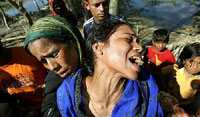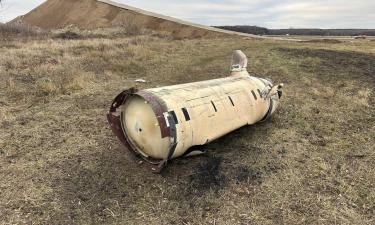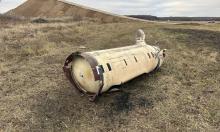Two people die of diarrhea in Bangladesh area ravaged by Cyclone Sidr
Two people died of diarrhea in Bangladesh in the area ruined by the Cyclone Sidr.

The cyclone zone has been struck with waterborne diseases and two children died of diarrhea on Tuesday in the hard-hit district of Patuakhali, Dhaka's Daily Star newspaper reported, quoting local health officials.
Government officials were not immediately available to confirm the newspaper report.
Aid agencies and U.N. officials were visiting the affected areas to assess the damage and the aid need, said Sakil Faizullah, a spokesman for the United Nations Development Program in Bangladesh .
Food, fresh water and temporary shelter had still not reached many of the exhausted survivors six days after the cyclone slammed into the low lying country.
"At this time we will welcome support from the international community," said a statement from the Bangladesh Foreign Ministry. "We are doing as best as we can do ourselves."
In a televised speech on Tuesday, the country's interim leader, Fakhruddin Ahmed, described the cyclone as "a national calamity" and urged citizens to help the affected people.
The government said international aid worth about US$120 million ( EUR 81.89 million) had so far been promised. But relief items such as tents, rice and water have been slow to reach most survivors of the worst cyclone to hit Bangladesh in a decade.
The European Commission announced Tuesday aid of US$9.6 million ( EUR 6.5 million). The American Red Cross said it would provide US$1.2 million ( EUR 819,000) to help get clean water to the survivors and build emergency shelters.
"The problem is that aid workers need hours to reach these remote areas. Poor communications are also hampering our work," said Anwarul Huq, a spokesman for the Bangladesh Rural Advancement Committee, the country's largest nonprofit development organization.
In many places, aid workers had to clear fallen trees and debris to get to survivors, said Huq, adding that rescuers also were facing a shortage of boats.
Nearly 3,000 volunteers from the committee have been distributing rice, lentils, salt, biscuits and candles to the survivors, he said.
In Moralganj, a local official on Wednesday laid out official papers in the town's main square after salvaging them from the flooded local administration office and before loading them into a truck.
The 1.83-meter (6-foot) high water tide rushed into the buildings in the town in Bagerhat district last week, affecting every resident, said Ali Azim, an account officer. The area is 135 kilometers (85 miles) south of Dhaka, the capital of Bangladesh.
"The bodies have been washing ashore every day. Authorities have recovered more than 100 bodies so far," Azim told The Associated Press.
At Patharghata, a hard-hit trading town on the Bay of Bengal, more than 100 women gathered Tuesday hoping to get aid.
"I've been waiting here for several hours hoping to get some food and drinking water," said Safura Begum, who has three children. "But I'm not sure it will come.
The storm, which tore along Bangladesh's southwestern coast on Thursday, left tens of thousands of people homeless and desperate for help.
The official death toll stood at 3,153, Lt. Col. Main Ullah Chowdhury, spokesman for the army that is coordinating the relief and rescue work, said Tuesday.
Local media reports say more than 4,000 people may have been killed. The Bangladesh Red Crescent Society, the Islamic equivalent of the Red Cross, has suggested the final figure could be around 10,000.
Subscribe to Pravda.Ru Telegram channel, Facebook, RSS!



